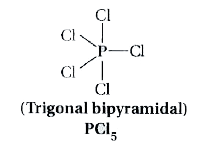Describe hybridization in the case of , and . The axial bonds are longer as compared to equatorial bonds in whereas in both axial bonds and equatorial bonds have the same bond length Explain.
Formation of
Electronic configuration of (ground state)
Electronic configuration of ( excited state )

In , phosphorus is d hybridised to produce a set of five d hybrid orbitals which are directed towards the five comers of trigonal bipyramidal . These five d hybrid orbitals. overlap with singly occupied p-orbitals of Cl -atoms to form five P - Cl sigma bonds.
Three P - Cl bonds are in one plane and make an angle of with each other. These bonds are called equatorial bonds.

The remaining two P - Cl bonds one lying above and other lying below the plane make an angle of with the equatorial plane. These bonds are called axial bonds. Axial bonds are slightly longer than equatorial bonds because axial bond pairs suffer more repulsive interaction from the equatorial bond pairs.
Formation of :
Electronic configuration of (ground state) s(excitedstate)

In . sulphur is hybridised to produce a set of six hybrid orbitals which are directed towards the six comers of a regular octahedron. These six hybrid orbitals overlap with singly occupied orbitals of fluorine atoms to form six S - F sigma bonds. Thus, molecule has a regular octahedral geometry and all S - F bonds have same bond length.
Topper's Solved these Questions
- CHEMICAL BONDING AND MOLECULAR STRUCTUREBook:KUMAR PRAKASHANChapter:CHEMICAL BONDING AND MOLECULAR STRUCTUREExercise:SECTION -D (SOLUTIONS OF NCERT EXEMPLAR PROBLEMS) (ASSERTION AND REASON)
Explore 3 Videos
- CLASSIFICATION OF ELEMENTS AND PERIODICITY IN PROPERTIES Book:KUMAR PRAKASHANChapter:CLASSIFICATION OF ELEMENTS AND PERIODICITY IN PROPERTIES Exercise:Section -D SOLUTIONS OF NCERT EXEMPLAR PROBLEMS (Long Answer Type Questions )
Explore 7 Videos
Similar Questions
Describe hybridisation in the case of PCl5andSF6 The axial bonds are longer as compared to equatorial bonds in PCl5 whereas in SF6 both axial bonds and equatorial bonds and have the same bond length. Explain.
View SolutionDescribe hybridisation in the case of PCl5andSF6 The axial bonds are longer as compared to equatorial bonds in PCl5 whereas in SF6 both axial bonds and equatorial bonds and have the same bond length. Explain.
View SolutionDescribe the hydribisation in case of PCl5. Why are the axial bonds longer as compared to equatorial bonds?
View SolutionDescribe the hybridisation in case of PCl2. Why are the axial bonds longer as compared to equatorial bonds ?
View SolutionDescribe the hybridisation in case of PCI5. Why are the axial bonds longer as compared to equatorial bonds?
View SolutionWhy axis bonds of PCl5 are longer than equatorial bonds ?
View SolutionHow many equitorial bonds are there are in PCl5 ?
View SolutionExplain the bond lengths of all P-Cl bonds in PCl5 molecule.
View SolutionHow many equitorial bonds are there are in PCl5 ?
View SolutionNumber of chlorine atoms which form equatorial bonds in PCl5 molecule are _
View Solution

